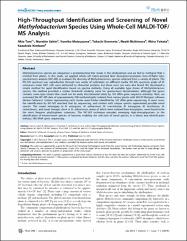| dc.contributor.author | Tani, Akio | |
| dc.contributor.author | Şahin, Nurettin | |
| dc.contributor.author | Matsuyama, Yumiko | |
| dc.contributor.author | Enomoto, Takashi | |
| dc.contributor.author | Nishimura, Naoki | |
| dc.contributor.author | Yokota, Akira | |
| dc.contributor.author | Kimbara, Kazuhide | |
| dc.date.accessioned | 2020-11-20T16:21:54Z | |
| dc.date.available | 2020-11-20T16:21:54Z | |
| dc.date.issued | 2012 | |
| dc.identifier.issn | 1932-6203 | |
| dc.identifier.uri | https://doi.org/10.1371/journal.pone.0040784 | |
| dc.identifier.uri | https://hdl.handle.net/20.500.12809/4089 | |
| dc.description | WOS: 000306366400059 | en_US |
| dc.description | PubMed ID: 22808262 | en_US |
| dc.description.abstract | Methylobacterium species are ubiquitous alpha-proteobacteria that reside in the phyllosphere and are fed by methanol that is emitted from plants. In this study, we applied whole-cell matrix-assisted laser desorption/ionization time-of-flight mass spectrometry analysis (WC-MS) to evaluate the diversity of Methylobacterium species collected from a variety of plants. The WC-MS spectrum was reproducible through two weeks of cultivation on different media. WC-MS spectrum peaks of M. extorquens strain AM1 cells were attributed to ribosomal proteins, but those were not were also found. We developed a simple method for rapid identification based on spectra similarity. Using all available type strains of Methylobacterium species, the method provided a certain threshold similarity value for species-level discrimination, although the genus contains some type strains that could not be easily discriminated solely by 16S rRNA gene sequence similarity. Next, we evaluated the WC-MS data of approximately 200 methylotrophs isolated from various plants with MALDI Biotyper software (Bruker Daltonics). Isolates representing each cluster were further identified by 16S rRNA gene sequencing. In most cases, the identification by WC-MS matched that by sequencing, and isolates with unique spectra represented possible novel species. The strains belonging to M. extorquens, M. adhaesivum, M. marchantiae, M. komagatae, M. brachiatum, M. radiotolerans, and novel lineages close to M. adhaesivum, many of which were isolated from bryophytes, were found to be the most frequent phyllospheric colonizers. The WC-MS technique provides emerging high-throughputness in the identification of known/novel species of bacteria, enabling the selection of novel species in a library and identification without 16S rRNA gene sequencing. | en_US |
| dc.description.sponsorship | Japan Science and Technology AgencyJapan Science & Technology Agency (JST); Sekisui Chemical Co.; Institute of Fermentation, Osaka (IFO); Ryobi Tei-en Memorial Foundation; Grants-in-Aid for Scientific ResearchMinistry of Education, Culture, Sports, Science and Technology, Japan (MEXT)Japan Society for the Promotion of ScienceGrants-in-Aid for Scientific Research (KAKENHI) [23688012] Funding Source: KAKEN | en_US |
| dc.description.sponsorship | This work was supported by a grant for Research for Promoting Technological Seeds from the Japan Science and Technology Agency and grants from Sekisui Chemical Co., the Institute of Fermentation, Osaka (IFO), and the Ryobi Tei-en Memorial Foundation. The funders had no role in study design, data collection and analysis, decision to publish, or preparation of the manuscript. | en_US |
| dc.item-language.iso | eng | en_US |
| dc.publisher | Public Library Science | en_US |
| dc.item-rights | info:eu-repo/semantics/openAccess | en_US |
| dc.title | High-Throughput Identification and Screening of Novel Methylobacterium Species Using Whole-Cell MALDI-TOF/MS Analysis | en_US |
| dc.item-type | article | en_US |
| dc.contributor.department | MÜ, Eğitim Fakültesi, Matematik Ve Fen Bilimleri Eğitimi Bölümü | en_US |
| dc.contributor.institutionauthor | Şahin, Nurettin | |
| dc.identifier.doi | 10.1371/journal.pone.0040784 | |
| dc.identifier.volume | 7 | en_US |
| dc.identifier.issue | 7 | en_US |
| dc.relation.journal | Plos One | en_US |
| dc.relation.publicationcategory | Makale - Uluslararası Hakemli Dergi - Kurum Öğretim Elemanı | en_US |


















